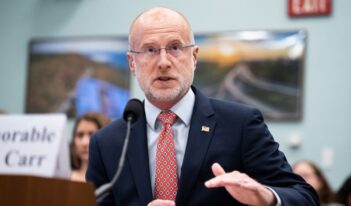
A private fairness doctrine could induce more accurate media by dismantling the political information bubble.
The riot at the U.S. Capitol building led promptly to former President Donald J. Trump’s impeachment and a trial in the U.S. Senate. But these responses will treat the symptom—not the cause.
The root of the problem that led to the trashing of the Capitol is not just President Trump—it is the spread of false information. Most Republicans still believe the “Stop the Steal” message, even after legal and legislative challenges against the movement have failed. Left unaddressed, today’s election myths could simply morph into a different challenge next month or next year.
The cause is clear. We all increasingly operate in information bubbles.
If I am conservative, I likely access my news from conservative sources and take cues about what to believe from conservative radio, Fox News, and—until recently—like-minded individuals and groups posting on Twitter and Facebook. Following these sources even briefly demonstrates that they provided Trump supporters with rationales that justified the assault on the Capitol. After all, if the election was stolen, should it not be up to citizens to try to stop it?
Although the immediate problem arises from the conservative information bubble, the bubble exists on the left as well. If I am progressive, I can restrict my information flow to MSNBC and liberal social media sources.
But whether I am on the left or the right of the political spectrum, I can remain in my bubble—untroubled by contrary facts or opinions—but angry about the bad acts of the other side.
On the surface, the only alternatives are unattractive: self-regulation or government regulation.
Self-regulation is in full swing right now. Twitter and Facebook have restricted the flow of information that has fed anger on the right, and Amazon, Apple, and Google have pressured Parler—a new social media platform with a large conservative base—to do the same. These private processes are not transparent or accountable, however, and have led to a conservative backlash that threatens to move conservatives more deeply into their own media bubble. In a recent Wall Street Journal interview, Richard Epstein has argued that they violate anti-competition norms as well.
The only thing worse than imperfect private media regulation is imperfect government regulation. Imagine a future leader similar to President Trump following through on threats to regulate Twitter in response to the media company’s decision to fact-check presidential tweets. The thought of a more sophisticated President pressuring the Federal Communications Commission (FCC) should send chills down the spine of any First Amendment advocate.
But there is another option that combines the independence of the private sector with the accountability and legitimacy of a well-functioning government: a private fairness doctrine.
The FCC relied on a government-enforced fairness doctrine in the past to police information broadcast by radio and television stations, requiring these broadcasters to give equal time to opposing viewpoints on controversial public issues. The FCC’s fairness doctrine provoked understandable First Amendment concerns on the left and right, and the Reagan-era FCC repealed it. But a new private fairness doctrine could overcome those concerns.
How exactly would a private fairness doctrine work?
It would, first of all, be privately created and administered. It would not require new legislation nor would it be implemented by a government agency. After the Trump Administration’s political involvement in regulatory agencies during these past four years, a major advantage of the doctrine would be that neither the FCC nor any other government agency subject to partisan political control would need to implement it.
Instead, the doctrine would take the form of a private standard run by a private secretariat with overall direction from a broad stakeholder group—similar to the successful efforts of the Marine Stewardship Council and other private certification and standards organizations.
In contrast with the one-off decisions currently being made by media executives, a private fairness standard would emanate from a broadly representative stakeholder group that would set standards for curating the information from traditional and new media. The stakeholder group would rate traditional and new media firms based on the transparency and efficacy of their curating systems, as well as grade media firms on their systems. The standard would be enforced by commitments from advertisers and media conduits to advertise only with A-rated firms.
A new private fairness doctrine would pose some risks and raise important questions about transparency and accountability. But the question is not whether a private system would be perfect. Rather, the question is how well it compares to the alternatives: the pre-1987 era with government control by the FCC, or the current era with largely ad hoc and opaque decision-making by advertisers and new media firms in response to public pressure.
A private fairness doctrine would be more effective and accountable than the current ad hoc, voluntary corporate regulatory regime and less threatening than government regulation.
In addition, this approach would harness market pressure and would maintain accountability since many companies respond to public preferences in ways that politicians no longer do. Indeed, most firms cannot gerrymander their markets.
The events of the last several months demonstrate that it is time to take risks to address the root causes of the information bubble. Do we have the foresight to do so, or will we continue to treat the symptoms, not the cause, of our dysfunctional democracy?




